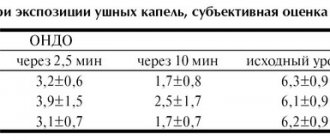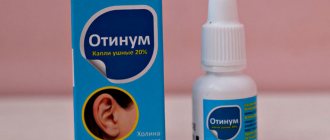Dancil 0.3% drops ear, eye dropper bottle 5 ml
A country
India
Country of manufacture may vary depending on the batch of goods. Please check with the operator for detailed information when confirming your order.
Active substance
Ofloxacin
pharmachologic effect
Antimicrobial agent of the fluoroquinolone group with a broad spectrum of action. The bactericidal effect of ofloxacin is associated with the blockade of the DNA gyrase enzyme in bacterial cells. Highly active against most gram-negative bacteria: Escherichia coli, Salmonella spp., Shigella spp., Proteus spp., Morganella morganii, Klebsiella spp. (including Klebsiella pneumoniae), Enterobacter spp., Serratia spp., Citrobacter spp., Yersinia spp., Providencia spp., Haemophilus influenzae, Neisseria gonorrhoeae, Neisseria meningitidis, Mycoplasma spp., Legionella pneumophila, Acinetobacter spp., as well as Chlamydia spp. Active against some gram-positive microorganisms (including Staphylococcus spp., Streptococcus spp., especially beta-hemolytic streptococci). Enterococcus faecalis, Streptococcus pneumoniae, Pseudomonas spp. are moderately sensitive to ofloxacin. Anaerobic bacteria (except Bacteroides ureolyticus) are not sensitive to ofloxacin. Resistant to β-lactamases.
Indications for use
Infectious and inflammatory diseases caused by microorganisms sensitive to ofloxacin, including: diseases of the lower respiratory tract, ear, throat, nose, skin, soft tissues, bones, joints, infectious and inflammatory diseases of the abdominal organs (with the exception of bacterial enteritis ) and pelvis, kidney and urinary tract infections, prostatitis, gonorrhea.
Mode of application
Individual. The daily dose is 200-800 mg, the frequency of use is 2 times a day. For patients with impaired renal function (creatinine clearance 20-50 ml/min), the first dose is 200 mg, then 100 mg every 24 hours. For creatinine clearance less than 20 ml/min, the first dose is 200 mg, then 100 mg every 48 hours. Contraindicated for use during pregnancy and lactation. Experimental studies have not revealed any negative effects on fertility in rats. Contraindicated in children and adolescents under 18 years of age.
Interaction
When used simultaneously with antacids containing calcium, magnesium or aluminum, with sucralfate, with drugs containing di- and trivalent cations such as iron, or with multivitamins containing zinc, the absorption of quinolones may be impaired, leading to a decrease in their concentration in the body. These drugs should not be used within 2 hours before or within 2 hours after taking ofloxacin. With the simultaneous use of ofloxacin and NSAIDs, the risk of developing a stimulating effect on the central nervous system and seizures increases. When used simultaneously with theophylline, it is possible to increase its concentration in the blood plasma (including at steady state), and increase T1/2. This increases the risk of developing adverse reactions associated with theophylline. With simultaneous use of ofloxacin with beta-lactam antibiotics, aminoglycosides and metronidazole, additive interactions were observed.
Side effect
From the digestive system: nausea, vomiting, diarrhea, abdominal pain and cramps, loss of appetite, dry mouth, flatulence, gastrointestinal dysfunction, constipation; rarely - liver dysfunction, liver necrosis, jaundice, hepatitis, intestinal perforation, pseudomembranous colitis, bleeding from the gastrointestinal tract, disorders of the oral mucosa, heartburn, increased activity of liver enzymes, including GGT and LDH, increased bilirubin levels in the blood serum. From the nervous system: insomnia, dizziness, fatigue, drowsiness, nervousness; rarely - convulsions, anxiety, cognitive changes, depression, pathological dreams, euphoria, hallucinations, paresthesia, syncope, tremor, confusion, nystagmus, suicidal thoughts or attempts, disorientation, psychotic reactions, paranoia, phobia, agitation, aggressiveness, emotional lability, peripheral neuropathy, ataxia, coordination disorders, exacerbation of extrapyramidal disorders, speech impairment. Allergic reactions: skin rash, itching; rarely - angioedema, urticaria, vasculitis, allergic pneumonitis, anaphylactic shock, erythema multiforme, Stevens-Johnson syndrome, erythema nodosum, exfoliative dermatitis, toxic epidermal necrolysis, conjunctivitis. From the reproductive system: itching in the area of the external genitalia in women, vaginitis, vaginal discharge; rarely - burning, irritation, pain and rash in the genital area in women, dysmenorrhea, menorrhagia, metrorrhagia, vaginal candidiasis. From the cardiovascular system: rarely - cardiac arrest, edema, arterial hypertension, arterial hypotension, palpitation, vasodilation, cerebral thrombosis, pulmonary edema, tachycardia. From the urinary system: rarely - dysuria, increased frequency of urination, urinary retention, anuria, polyuria, kidney stone formation, renal failure, nephritis, hematuria, albuminuria, candiduria. From the musculoskeletal system: rarely - arthralgia, myalgia, tendinitis, muscle weakness, exacerbation of myasthenia gravis. Metabolic: rarely - thirst, weight loss, hyper- or hypoglycemia (especially in patients with diabetes mellitus receiving insulin or oral hypoglycemic agents), acidosis, increase in serum TG, cholesterol, potassium. From the respiratory system: rarely - cough, nasal discharge, respiratory arrest, dyspnea, bronchospasm, stridor. From the senses: rarely - hearing impairment, tinnitus, diplopia, nystagmus, impaired clarity of visual perception, impaired taste, smell, photophobia. Dermatological reactions: rarely - photosensitivity, hyperpigmentation, vesiculobullous rashes. From the hematopoietic system: rarely - anemia, bleeding, pancytopenia, agranulocytosis, leukopenia, reversible inhibition of bone marrow hematopoiesis, thrombocytopenia, thrombocytopenic purpura, petechiae, ecchymosis, increased prothrombin time. Other: chest pain, pharyngitis, fever, body pain; rarely - asthenia, chills, general malaise, nosebleeds, increased sweating.
Contraindications
Pregnancy, lactation, childhood and adolescence under 18 years of age, hypersensitivity to ofloxacin or other quinolone derivatives.
special instructions
Use with caution in patients with impaired renal and hepatic function. During treatment, it is necessary to monitor blood glucose levels. With long-term therapy, it is necessary to periodically monitor the functions of the kidneys, liver, and peripheral blood picture. When using ofloxacin, the body should be sufficiently hydrated and the patient should not be exposed to ultraviolet radiation. Experimental studies have not revealed any mutagenic potential. Long-term studies to determine the carcinogenicity of ofloxacin have not been conducted. In studies in juvenile animals of several species, ofloxacin caused arthropathy and osteochondrosis. Safety and effectiveness in children and adolescents under 18 years of age have not been established. Effect on the ability to drive vehicles and operate machinery Use with caution in patients whose activities require high concentration and speed of psychomotor reactions.
Dispensing conditions in pharmacies
On prescription
Dancil (vial-drops for eyes, ear drops 0.3% 5ml)
A country
India
Country of manufacture may vary depending on the batch of goods. Please check with the operator for detailed information when confirming your order.
Compound
Bottle 5 ml
Ofloxacin 3 mg.
pharmachologic effect
Antimicrobial agent of the fluoroquinolone group with a broad spectrum of action. The bactericidal effect of ofloxacin is associated with the blockade of the DNA gyrase enzyme in bacterial cells. Highly active against most gram-negative bacteria: Escherichia coli, Salmonella spp., Shigella spp., Proteus spp., Morganella morganii, Klebsiella spp. (including Klebsiella pneumoniae), Enterobacter spp., Serratia spp., Citrobacter spp., Yersinia spp., Providencia spp., Haemophilus influenzae, Neisseria gonorrhoeae, Neisseria meningitidis, Mycoplasma spp., Legionella pneumophila, Acinetobacter spp., as well as Chlamydia spp. Active against some gram-positive microorganisms (including Staphylococcus spp., Streptococcus spp., especially beta-hemolytic streptococci). Enterococcus faecalis, Streptococcus pneumoniae, Pseudomonas spp. are moderately sensitive to ofloxacin. Anaerobic bacteria (except Bacteroides ureolyticus) are not sensitive to ofloxacin. Resistant to β-lactamase.
Indications for use
Infectious and inflammatory diseases caused by microorganisms sensitive to ofloxacin, including: diseases of the lower respiratory tract, ear, throat, nose, skin, soft tissues, bones, joints, infectious and inflammatory diseases of the abdominal organs (with the exception of bacterial enteritis ) and pelvis, kidney and urinary tract infections, prostatitis, gonorrhea.
Mode of application
Individual. The daily dose is 200-800 mg, the frequency of use is 2 times a day. For patients with impaired renal function (creatinine clearance 20-50 ml/min), the first dose is 200 mg, then 100 mg every 24 hours. For creatinine clearance less than 20 ml/min, the first dose is 200 mg, then 100 mg every 48 hours.
Interaction
When used simultaneously with antacids containing calcium, magnesium or aluminum, with sucralfate, with drugs containing di- and trivalent cations such as iron, or with multivitamins containing zinc, the absorption of quinolones may be impaired, leading to a decrease in their concentration in the body. These drugs should not be used within 2 hours before or within 2 hours after taking ofloxacin. With the simultaneous use of ofloxacin and NSAIDs, the risk of developing a stimulating effect on the central nervous system and seizures increases. When used simultaneously with theophylline, it is possible to increase its concentration in the blood plasma (including at steady state), and increase T1/2. This increases the risk of developing adverse reactions associated with theophylline. With simultaneous use of ofloxacin with beta-lactam antibiotics, aminoglycosides and metronidazole, additive interactions were observed.
Side effect
From the digestive system: - nausea, vomiting, diarrhea, abdominal pain and cramps, loss of appetite, dry mouth, flatulence, gastrointestinal dysfunction, constipation; - rarely - liver dysfunction, liver necrosis, jaundice, hepatitis, intestinal perforation, pseudomembranous colitis, gastrointestinal bleeding, disorders of the oral mucosa, heartburn, increased activity of liver enzymes, including GGT and LDH, increased bilirubin levels in the blood serum. From the nervous system: - insomnia, dizziness, fatigue, drowsiness, nervousness; - rarely - convulsions, anxiety, cognitive changes, depression, pathological dreams, euphoria, hallucinations, paresthesia, syncope, tremor, confusion, nystagmus, suicidal thoughts or attempts, disorientation, psychotic reactions, paranoia, phobia, agitation, aggressiveness, emotional lability , peripheral neuropathy, ataxia, coordination disorders, exacerbation of extrapyramidal disorders, speech impairment. Allergic reactions: skin rash, itching; rarely - angioedema, urticaria, vasculitis, allergic pneumonitis, anaphylactic shock, erythema multiforme, Stevens-Johnson syndrome, erythema nodosum, exfoliative dermatitis, toxic epidermal necrolysis, conjunctivitis. From the reproductive system: - itching in the area of the external genitalia in women, vaginitis, vaginal discharge; - rarely - burning, irritation, pain and rash in the genital area in women, dysmenorrhea, menorrhagia, metrorrhagia, vaginal candidiasis. From the cardiovascular system: rarely - cardiac arrest, edema, arterial hypertension, arterial hypotension, palpitation, vasodilation, cerebral thrombosis, pulmonary edema, tachycardia. From the urinary system: rarely - dysuria, increased frequency of urination, urinary retention, anuria, polyuria, kidney stone formation, renal failure, nephritis, hematuria, albuminuria, candiduria. From the musculoskeletal system: rarely - arthralgia, myalgia, tendinitis, muscle weakness, exacerbation of myasthenia gravis. Metabolic: rarely - thirst, weight loss, hyper- or hypoglycemia (especially in patients with diabetes mellitus receiving insulin or oral hypoglycemic agents), acidosis, increase in serum TG, cholesterol, potassium. From the respiratory system: rarely - cough, nasal discharge, respiratory arrest, dyspnea, bronchospasm, stridor. From the senses: rarely - hearing impairment, tinnitus, diplopia, nystagmus, impaired clarity of visual perception, impaired taste, smell, photophobia. Dermatological reactions: rarely - photosensitivity, hyperpigmentation, vesiculobullous rashes. From the hematopoietic system: rarely - anemia, bleeding, pancytopenia, agranulocytosis, leukopenia, reversible inhibition of bone marrow hematopoiesis, thrombocytopenia, thrombocytopenic purpura, petechiae, ecchymosis, increased prothrombin time. Other: chest pain, pharyngitis, fever, body pain; rarely - asthenia, chills, general malaise, nosebleeds, increased sweating.
Contraindications
Pregnancy, lactation, childhood and adolescence under 18 years of age, hypersensitivity to ofloxacin or other quinolone derivatives.
special instructions
Use with caution in patients with impaired renal and hepatic function. During treatment, it is necessary to monitor blood glucose levels. With long-term therapy, it is necessary to periodically monitor the functions of the kidneys, liver, and peripheral blood picture. When using ofloxacin, the body should be sufficiently hydrated and the patient should not be exposed to ultraviolet radiation. Experimental studies have not revealed any mutagenic potential. Long-term studies to determine the carcinogenicity of ofloxacin have not been conducted. In studies in juvenile animals of several species, ofloxacin caused arthropathy and osteochondrosis. Safety and effectiveness in children and adolescents under 18 years of age have not been established. Effect on the ability to drive vehicles and operate machinery Use with caution in patients whose activities require high concentration and speed of psychomotor reactions.
Dispensing conditions in pharmacies
On prescription

